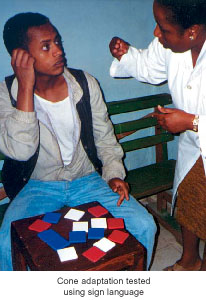Visual adaptation to low light levels
 Visual adaptation to lower luminance levels can be assessed quickly by using the Cone Adaptation Test. The test can be performed in a room that can be brought to low luminance level by turning off the ceiling lights or by closing the door. The low (mesopic) luminance level is chosen so that it takes about 4 - 5 seconds for the examiner to start seeing colours again, i.e. when the cone cells have sufficiently adapted to function at this lower luminance level.
Visual adaptation to lower luminance levels can be assessed quickly by using the Cone Adaptation Test. The test can be performed in a room that can be brought to low luminance level by turning off the ceiling lights or by closing the door. The low (mesopic) luminance level is chosen so that it takes about 4 - 5 seconds for the examiner to start seeing colours again, i.e. when the cone cells have sufficiently adapted to function at this lower luminance level.
The luminance value of red and blue chips must be closely equal at low mesopic (twilight) luminance, so that the luminance difference cannot be used to separate the chips but the colours must be seen. We are more sensitive to blue light in twilight than we are to red, therefore the blue pieces are darker in photopic (daylight) vision.
The mesopic light level of the test situation requires that the tester has normal cone adaptation and starts to discern the colours after 4-5 seconds of adaptation. This luminance level is usually arranged so that a small lamp in a corner of the room is the only light source.
Mix the red, blue and white chips on a dark table or cloth and ask the child to sort them in three piles, each colour in a separate pile in the regular room light. If the child can do this, tell the child that the chips will be mixed again, this time the lights will be turned off and it will become rather dark. The child's task will be to sort the coloured chips again in three piles as quickly as possible.
The white chips appear to 'glow' in the dark and thus the child will start picking them. Since there are five white chips, it takes about 5 seconds to pick them, at which time a normally sighted child starts seeing the difference between red and blue and can go on sorting them, whereas a child who has delayed cone adaptation must stop because he/she cannot see the difference between red and blue. Thus in a few seconds you detect abnormal function of the cone cells in a play situation. The game may be played several times until the child's performance is repeatable.
The practical consequences of delayed cone adaptation are difficulties in finding things in poorly lit areas, so these children need a torch/flashlight if they are sent to get something from a dark place. The child's way to and from school and to and from evening activities needs to be considered and the need for orientation and mobility instruction to remain independent in moving around at night must be recognized. In the countryside where there are no streetlights, dawn and dusk may cause orientation problems starting at early teen-age.
Previous Chapter 
|
 Next Chapter Next Chapter
|